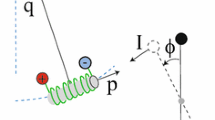Abstract
We study manifolds describing the behavior of motions close to the origin and at infinity of configuration space, for mechanical systems with homogeneous potentials. We find an inversion between these behaviors when the sign of the degree of homogeneity is changed. In some cases, the blow up equations can be written in canonical form, by first reducing to a contact structure. A motivation for the use of blow-up techniques is given, and some examples are studied in detail.
Similar content being viewed by others
References
Arnold, V. I.:Mathematical Methods of Classical Mechanics, Springer-Verlag, N.Y. (1978).
Arnold, V. I.:Geometrical Methods in the Theory of Ordinary Differential Equations, Springer-Verlag, N.Y. (1983).
Broucke, R.: Simple non integrable systems with two degrees of freedom, in V.Szebehely (ed.),Instabilities in Dynamical Systems, D. Reidel, Dordrecht (1979).
Bryant, J.: Le formalisme de contact en mécanique classique et relativiste,Ann. Inst. Henri Poincaré 38 (1983), 121–152.
Devaney, R. L.: Singularities in classical mechanical systems, in A.Katok, (ed.),Ergodic Theory and Dynamical Systems I, Birkhäuser, Basle, p. 211 (1981).
Griffiths, P. and Harris, J.:Principles of Algebraic Geometry, John Wiley, N.Y. (1978).
Lacomba, E. A.: Variétés de l'infini pour une énergie non nulle en mécanique célèste,Comptes Rendus Acad. Sci. Paris 295-I (1982), 503–506.
Lacomba, E. A.: Infinity manifolds for positive energy in celestial mechanics, Proc. Lefschetz International Conference,Contemporary Math. 58, Part III (1987), 193–201.
Lacomba, E. A. and Bryant, J.: Contact structures for total collision and zero energy infinity manifolds in celestial mechanics,Atti Accad. Sci. Torino, Suppl. 117 (1983), 563–568.
Lacomba, E. A. and Simó, C.: Boundary manifolds for energy surfaces in celestial mechanics,Celestial Mech. 28 (1982), 37–48.
Lichnerowicz, A.: Variétés symplectiques, variétés canoniques et systèmes dynamiques,Topics in Differential Geometry, Academic Press, N.Y., pp. 57–85 (1976).
Losco, L.: Sur un théorème de stabilité pour un potentiel homogène,Celestial Mech. 28 (1982), 63–68.
McGehee, R.: Triple collision in the collinear three-body problem,Invent. Math. 27 (1974), 191–227.
Smale, S.: Topology and mechanics I, II,Invent. Math. 10 (1970), 305–331;11 (1970), 45–64.
Author information
Authors and Affiliations
Additional information
Research partially supported by CONACyT (Mexico), under grants PCCBNAL 790178 and PCCBBNA 022553.
Member of CIFMA (Mexico). On sabbatical leave at the University of Barcelona during the year 1987–88.
Rights and permissions
About this article
Cite this article
Lacomba, E.A., Ibort, L.A. Origin and infinity manifolds for mechanical systems with homogeneous potentials. Acta Applicandae Mathematicae 11, 259–284 (1988). https://doi.org/10.1007/BF00140121
Received:
Revised:
Issue Date:
DOI: https://doi.org/10.1007/BF00140121




